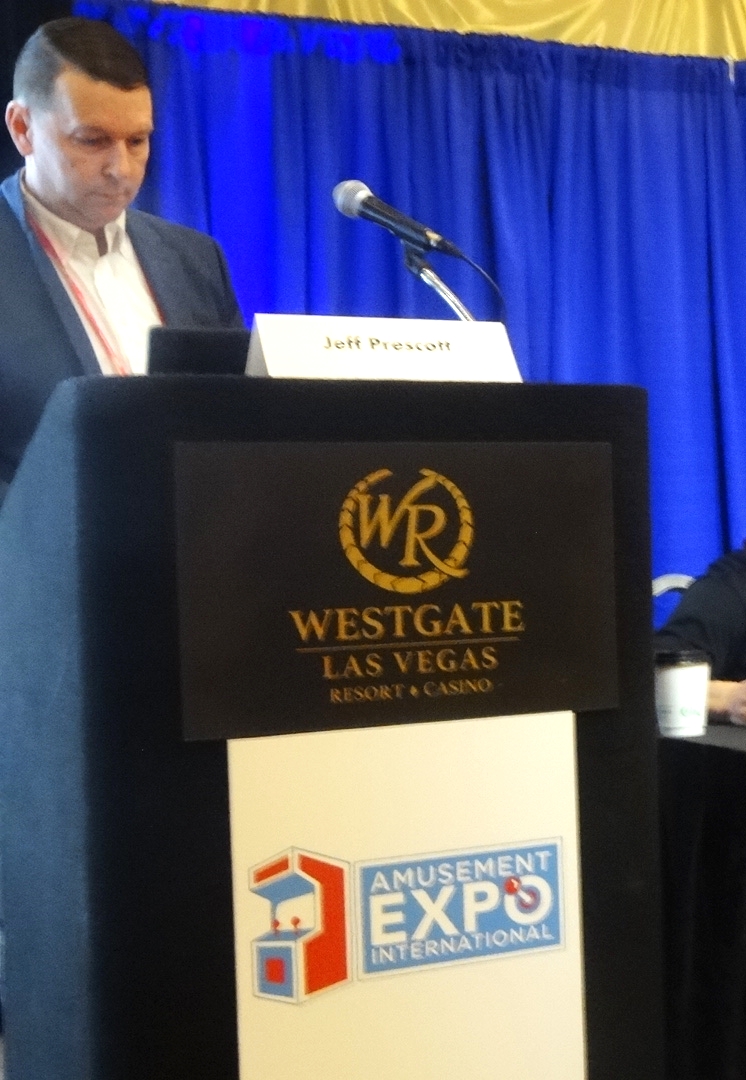


The cashless trend is growing, but companies are struggling to actually deploy those solutions. And in the meantime, cash isn't going anywhere.
 Image via Istock.com
Image via Istock.com
Consumers nowadays are less likely to use cash for nearly any type of purchase, but for many businesses, knowing what cashless payment solutions to offer is not as simple as replacing bill acceptors with credit card readers.
Cashless technology isn't cheap, and as technology evolves, payment equipment can become obsolete.
Hence, it was no surprise that an education session titled, "The Ever Evolving World of Cashless" drew a packed audience during the recent Amusement Expo International show at the Las Vegas Convention Center. The session was moderated by Jeff Prescott, president of Valley Vending Service Inc. in Plattsburgh, New York.
 |
| Frank Licausi, Jason MItchell, Jonathan Durst and Jordan Barberio address the benefits and challenges of cashless technology during the Amusement Industry Expo. |
The panel, which included one amusement machine operator and three cashless equipment providers, explored the benefits cashless payment offers customers and operators as well as the challenges operators are facing in the current business climate.
Panelists wasted no time rattling off the numerous benefits cashless delivers.
"The credit card revenue just completely took us to the next level," said Jordan Barberio, owner and vice president at Barberio Entertainment Co. in San Antonio, Texas. "That's been a huge advantage for us."
At minimum, Barberio said location revenue jumps 20% when credit card readers are installed without any price increase. Some locations quadrupled sales, while some boxing machines went from $200 to $500 per week.
Another positive is you can raise prices with less customer resistance.
"It's very difficult to charge $1 on a crane and go to $1.25," he said, recalling how it was when the machines accepted only cash. "But on a card system, your customers, they don't even think twice."
Another benefit Barberio cited is reduced labor cost. Ten years ago, the company sent someone to the bank daily. Since deploying credit card readers, they now go to the bank once a week.
"In my opinion, you can't afford not to have a card system because product cost is going up, your equipment cost is going up," he said.
Jason Mitchell, manager of North American sales at Intercard Inc., a provider of cashless technology, agreed.
After replacing coin changers in games in restaurants with card systems, employees are now spending half an hour instead of two hours at each location, Mitchell said.
In addition, cashless sales data is easier to manage.
"It's much more efficient to view your business, even all of your business, from home," Mitchell said. "All your data is right there in front of you instantaneously."
 |
| Jeff Prescott moderates the panel. |
On the cost side, card systems have declined in price in the last five or six years, Mitchell said, as card system suppliers have recognized that the smaller markets are very viable, including sites with three to five games.
Jonathan Durst, a salesman at Pyramid Technologies Inc., a manufacturer of payment equipment and thermal printers, agreed that the hardware costs have plummeted, and he believes the costs will continue to decline in the next two years while the transaction costs will become more competitive.
"You have the option to pass down some of the transactional costs to customers," Durst said.
Durst further pointed out that the pandemic has accelerated consumer acceptance of cashless.
"There has been an increased aversion to cash…at the height of the pandemic, 50% of customers were avoiding using cash because they believed it carried disease, even though it was proven very early on that that's not the case; it's not transmitting over surfaces," Durst said.
Remote management enabled by connectivity was another cashless benefit cited.
"It allows you to run your business from one location," Mitchell said. "Even if you have 30 locations, you have a centralized computer that manages the data and you have centralized reporting, centralized pricing…you can be in your office or on the road, and as long as you have your software on your phone, you can see what's happening in a matter of seconds as long as you have connectivity."
If you lose connectivity at a customer site, there are backups in place that will "trip over" to a mobile solution or an onsite server that will manage all locations locally until the main connection is restored, he said.
"There should never be a time where your business is down or your site is down," Mitchell said. Guests should always be able to spin, earn or redeem without an issue.
Frank Licausi, owner of Amusement Connect, a provider of a game card system, cited the experience of a resort that is completely cashless.
"The operator loves it; there's no money to count; his costs have gone way down," Licausi said.
But despite all the benefits, the panelists were far from ready to declare cash dead.
"Be realistic," Barberio said. "You're not going to be able to pull your bill acceptors off of games any time soon."
Durst agreed.
"Surprisingly here in the U.S., the market has never been stronger on the hardware of the bill," Durst said. "That was not foreseen."
The move to complete cashless has been much slower in the U.S. than other markets, he said, noting that even facilities that advertise themselves as all cashless still accept cash.
The panelists affirmed that, in response to concerns raised by operators in the room, card systems can interface with retail POS systems.
"There are a lot of different interfaces between card systems and third party POS systems that are in play," Mitchell said. "The card system company will have an enhanced APi," which creates an interface to the POS.
The major third party POS providers have these interfaces, he said.
Meanwhile, operators must continue to invest in cashless equipment as payment equipment evolves.
Durst observed that EMV compliant payment equipment is needed to prevent chargebacks on credit card purchases.
Banks that authorize credit cards now have software that can catch credit card transactions where an EMV credit card (which is most of today's cards) was used in a non-EMV compliant card reader, automatically initiating a chargeback.
"If that card was capable and you did a 'swipe only,' it (a chargeback) can be initiated by a third party software," Durst told this website in a phone interview following the panel. The consumer doesn't even know the chargeback is happening, and the operator gets hit with the fee.
"That amusement transaction is low hanging fruit, and it would be a source of revenue for banking," Durst said. "I think it's a potential threat."
(Editor's note: The major card brands — Visa, MasterCard, American Express and Discover — are requiring EMV for unattended contactless [tap card and NFC card] transactions. The card brands have shifted the liability for card fraud losses to acquirers and passing them on to merchants and operators unless EMV capable cards are processed on EMV compliant payment terminals, as previously reported.)
The panelists also agreed that cashless payments are not successful on every type of equipment.
Barberio said he has seen good response to having a card reader on a punching bag and a hoops game, but not on a pool table or a juke box.
"There are some games that won't work; some games that completely go to the next level," he said.
As enthusiastic as the panelists were for cashless, existing technology will not last indefinitely.
Durst said Amazon has introduced its cashierless technology at the Javits Center in New York City. He expects to see this technology to emerge in sports stadiums.
"There's not going to be any holding out a card or a tap…you simply are logged into your profile and you just grab what you want," Durst said.
"They could recognize you anywhere in the world right now with a couple cameras…it's strange, but that is where this is going. There's absolutely no friction in payment whatsoever."
Mitchell agreed.
"You won't need any hardware at the location…the game card will be a thing of the past," Mitchell said. He offered the following scenario:
"You'll have a QR code that's on the wall. The customer will scan it with their phone camera that will take them to a URL…once they get that information (on whatever they are buying) and they pay…they'll be issued a virtual card; that virtual card can be placed into their Google wallet or their Apple Pay, whatever technology they're using, and that will be brought up and scanned on a reader on a game to play the game."
In the meantime, Licausi advised everyone using a card system to stock up on cards since they are more difficult to source on account of the supply chain issue.
"Do what you can to plan farther ahead than you might expect," Licausi said.
Elliot Maras is the editor of Kiosk Marketplace and Vending Times. He brings three decades covering unattended retail and commercial foodservice.
Sign up now for the ATM Marketplace newsletter and get the top stories delivered straight to your inbox.
Privacy PolicySeptember 9-11, 2024 | Charlotte, NC